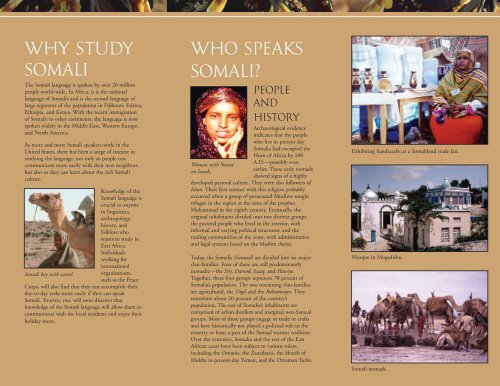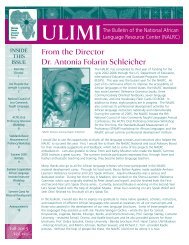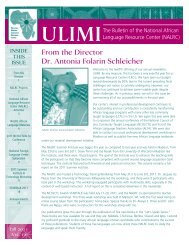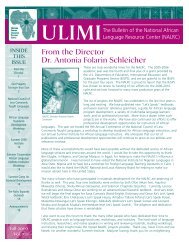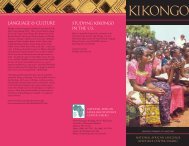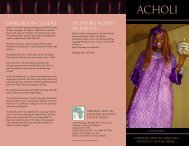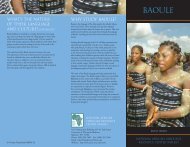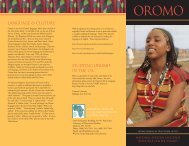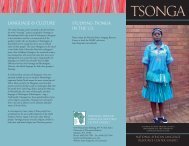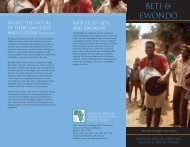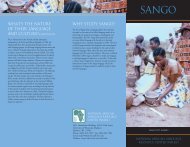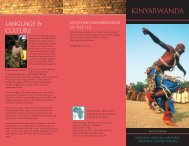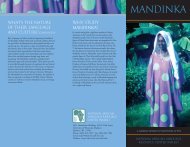Somali - National African Language Resource Center
Somali - National African Language Resource Center
Somali - National African Language Resource Center
You also want an ePaper? Increase the reach of your titles
YUMPU automatically turns print PDFs into web optimized ePapers that Google loves.
Why Study<br />
<strong>Somali</strong><br />
The <strong>Somali</strong> language is spoken by over 20 million<br />
people world-wide. In Africa, it is the national<br />
language of <strong>Somali</strong>a and is the second language of<br />
large segments of the population in Djibouti, Eritrea,<br />
Ethiopia, and Kenya. With the recent immigration<br />
of <strong>Somali</strong>s to other continents, the language is now<br />
spoken widely in the Middle-East, Western Europe,<br />
and North America.<br />
As more and more <strong>Somali</strong> speakers settle in the<br />
United States, there has been a surge of interest in<br />
studying the language, not only so people can<br />
communicate more easily with their new neighbors,<br />
but also so they can learn about the rich <strong>Somali</strong><br />
culture.<br />
Knowledge of the<br />
<strong>Somali</strong> language is<br />
crucial to anyone<br />
in linguistics,<br />
anthropology,<br />
history, and<br />
folklore who<br />
wants to study in<br />
East Africa.<br />
Individuals<br />
working for<br />
international<br />
<strong>Somali</strong> boy with camel. organizations,<br />
such as the Peace<br />
Corps, will also find that they can accomplish their<br />
day-to-day tasks more easily if they can speak<br />
<strong>Somali</strong>. Tourists, too, will soon discover that<br />
knowledge of the <strong>Somali</strong> language will allow them to<br />
communicate with the local residents and enjoy their<br />
holiday more.<br />
Who Speaks<br />
somali<br />
People<br />
and<br />
History<br />
Archaeological evidence<br />
indicates that the people<br />
who live in present day<br />
<strong>Somali</strong>a had occupied the<br />
Horn of Africa by 100<br />
Woman with ‘heena’<br />
on hands.<br />
A.D.—possibly even<br />
earlier. These early nomads<br />
showed signs of a highly<br />
developed pastoral culture. They were also followers of<br />
Islam. Their first contact with this religion probably<br />
occurred when a group of persecuted Muslims sought<br />
refugee in the region at the time of the prophet<br />
Muhammad in the eighth century. Eventually, the<br />
original inhabitants divided into two distinct groups:<br />
the pastoral people who lived in the interior, with<br />
informal and varying political structures; and the<br />
trading communities of the coast, with administrative<br />
and legal systems based on the Muslim sharia.<br />
Today, the <strong>Somali</strong>s (Samaal) are divided into six major<br />
clan-families. Four of these are still predominantly<br />
nomadic—the Dir, Darood, Isaaq, and Hawiye.<br />
Together, these four groups represent 70 percent of<br />
<strong>Somali</strong>a’s population. The two remaining clan-families<br />
are agricultural, the Digil and the Rahanwayn. They<br />
constitute about 20 percent of the country’s<br />
population. The rest of <strong>Somali</strong>a’s inhabitants are<br />
comprised of urban dwellers and marginal non-Samaal<br />
groups. Most of these groups engage in trade or crafts<br />
and have historically not played a political role in the<br />
country or been a part of the Samaal warrior tradition.<br />
Over the centuries, <strong>Somali</strong>a and the rest of the East<br />
<strong>African</strong> coast have been subject to various rulers,<br />
including the Omanis, the Zanzibaris, the Sharifs of<br />
Mukha in present-day Yemen, and the Ottoman Turks.<br />
Exhibiting handicrafts at a <strong>Somali</strong>land trade fair.<br />
Mosque in Mogadishu.<br />
<strong>Somali</strong> nomads.


